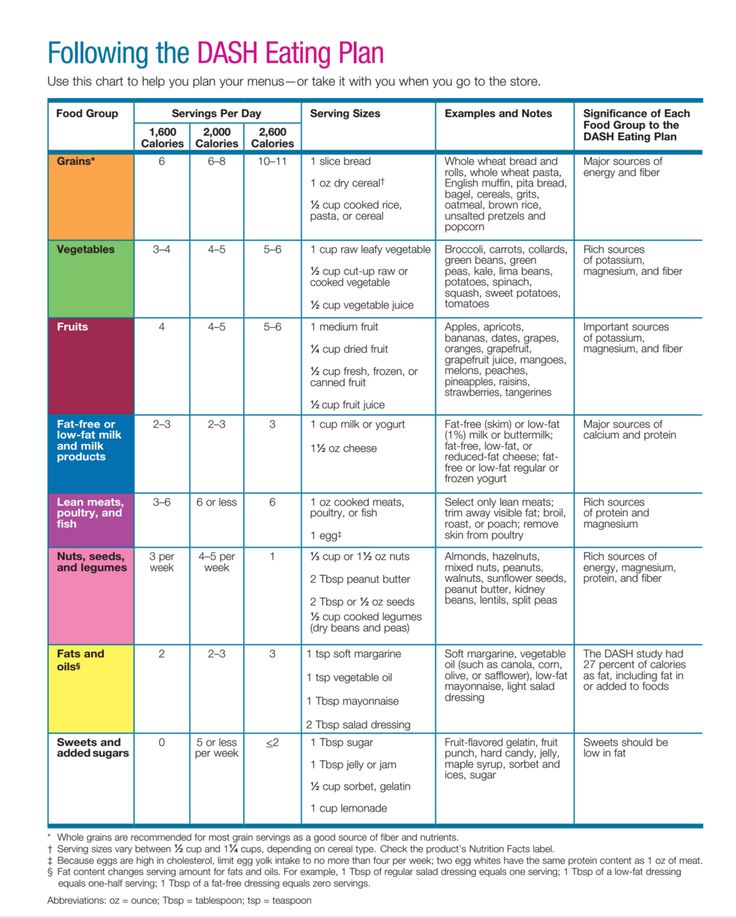Contraction definition pregnancy
Contractions and signs of labor
Learning the signs of labor before your due date can help you feel ready for your baby’s birth.
Signs of labor include strong and regular contractions, pain in your belly and lower back, a bloody mucus discharge and your water breaking.
If you think you’re in labor, call your health care provider.
Not all contractions mean you're in true labor. Learning the difference between true and false labor can help you know when it’s the real thing.
What is labor?
Labor (also called childbirth) is the process of your baby leaving the uterus (womb). You’re in labor when you have regular contractions that cause your cervix to change. Contractions are when the muscles of your uterus get tight and then relax. Contractions help push your baby out of your uterus. Your cervix is the opening to the uterus that sits at the top of the vagina. When labor starts, your cervix dilates (opens up).
As you get closer to your due date, learning the signs of labor can help you feel ready for labor and birth. If you have any signs of labor, call your health care provider.
What are the signs of labor?
You know you’re in true labor when:
- You have strong and regular contractions. A contraction is when the muscles of your uterus tighten up like a fist and then relax. Contractions help push your baby out. When you’re in true labor, your contractions last about 30 to 70 seconds and come about 5 to 10 minutes apart. They’re so strong that you can’t walk or talk during them. They get stronger and closer together over time.
- You feel pain in your belly and lower back. This pain doesn't go away when you move or change positions.
- You have an increase in vaginal discharge that can be clear, pink or slightly bloody (brownish or reddish). This is called bloody show. It can happen a few days before labor or at the beginning of labor.
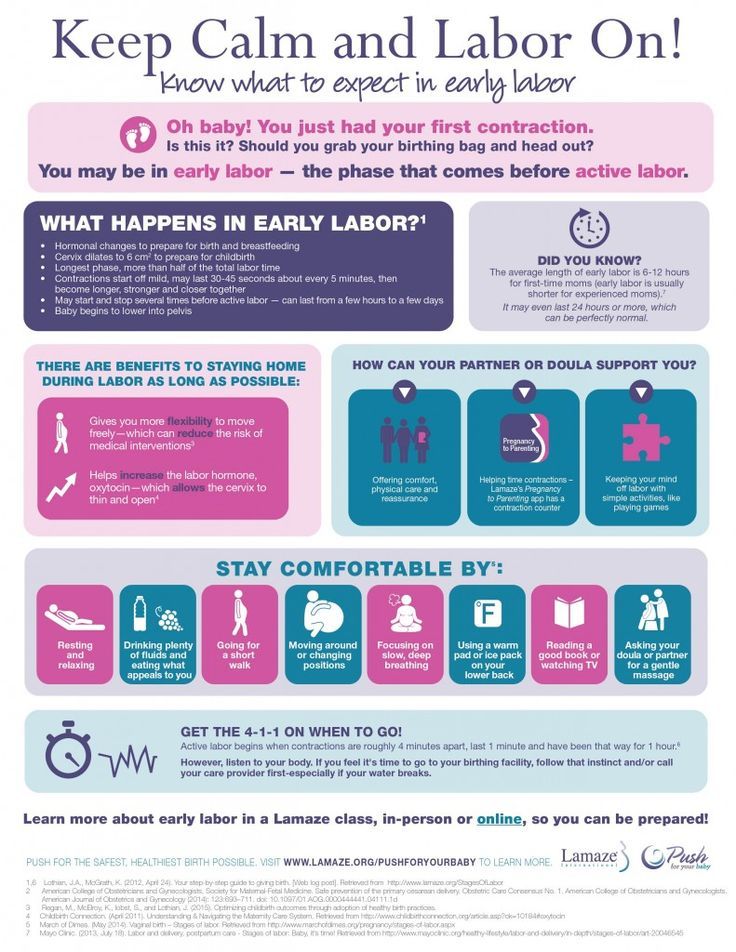 If you have bright red bleeding or if the bleeding is heavy, tell your provider right away.
If you have bright red bleeding or if the bleeding is heavy, tell your provider right away. - Your water breaks. Your baby has been growing in amniotic fluid (the bag of waters) in your uterus. When the bag of waters breaks, you may feel a big rush of water. Or you may feel just a trickle.
If you think you’re in labor, call your health care provider, no matter what time of day or night. Your provider can tell you if it’s time to head for the hospital. To see for sure that you’re in labor, your health care provider measures your cervix.
What are signs that you may be close to starting labor?
You may be close to starting labor if:
- Your baby drops or moves lower into your pelvis. This is called lightening. It means that your baby is getting ready to move into position for birth. It can happen a few weeks or even just a few hours before your labor begins.
- You have an increase in vaginal discharge that’s clear, pink or slightly bloody.
 This is called show or bloody show. It can happen a few days before labor starts or at the beginning of labor.
This is called show or bloody show. It can happen a few days before labor starts or at the beginning of labor. - At a prenatal checkup, your health care provider tells you that your cervix has begun to efface (thin) and dilate (open). Before labor, your cervix is about 3.5 to 4 centimeters long. When it’s fully dilated (open) for labor, it’s 10 centimeters. Once labor starts, contractions help open your cervix.
- You have the nesting instinct. This is when you want to get things organized in your home to get ready for your baby. You may want to do things like cook meals or get the baby’s clothes and room ready. Doing these things is fine as long as you’re careful not to overdo it. You need your energy for labor and birth.
If you have any of these signs, you may start labor soon. Learn the signs of labor so you know when to call your provider.
What are false labor and Braxton-Hicks contractions?
Not all contractions mean you’re in labor. You may have contractions on and off before true labor starts. These contractions are called false labor or Braxton-Hicks contractions. They soften and thin the cervix to help your body get ready for labor and birth. You may feel them in the weeks right before your due date. Learning the differences between true labor contractions and false labor contractions can help you know when you’re really in labor.
You may have contractions on and off before true labor starts. These contractions are called false labor or Braxton-Hicks contractions. They soften and thin the cervix to help your body get ready for labor and birth. You may feel them in the weeks right before your due date. Learning the differences between true labor contractions and false labor contractions can help you know when you’re really in labor.
It can be hard to tell the difference between true labor and false labor. When you first feel contractions, time them. Write down how much time it takes from the start of one contraction to the start of the next. Make a note of how strong the contractions feel. Keep a record of your contractions for 1 hour. Walk or move around to see if the contractions stop when you change positions.
What is preterm labor?
Preterm labor is labor that begins too early, before 37 weeks of pregnancy. Premature babies (born before 37 weeks of pregnancy) can have health problems at birth and later in life.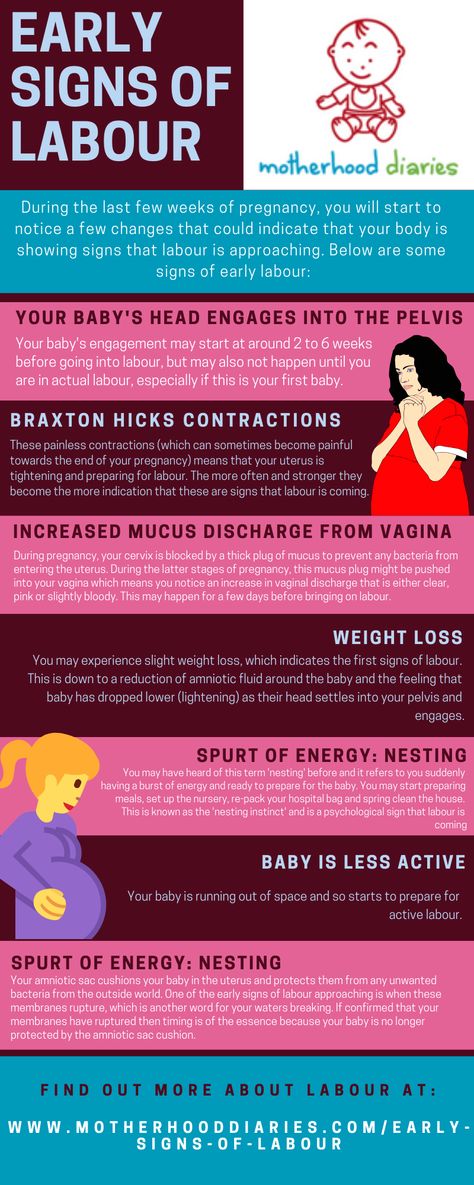 If you’re not to 37 weeks of pregnancy and you have signs or symptoms of preterm labor, call your provider. Getting help quickly is the best thing you can do. Learn about risk factors for preterm labor and what you can do to help reduce your risk.
If you’re not to 37 weeks of pregnancy and you have signs or symptoms of preterm labor, call your provider. Getting help quickly is the best thing you can do. Learn about risk factors for preterm labor and what you can do to help reduce your risk.
What are stages of labor?
Stages of labor include the whole process of labor, from your first contractions (stage 1) to pushing (stage 2) to delivery of the placenta (stage 3) after your baby is born. Learning about the stages of labor can help you know what to expect during labor and birth.
Last reviewed: December, 2018
Here's What You Need to Know
Written by Stephanie Watson
In this Article
- Why Do You Get Them?
- What Do They Feel Like?
- Braxton Hicks Contractions
- How to Know You're in Labor
- When to Call Your Doctor
Once you reach week 37 of your pregnancy, it becomes a waiting game until delivery. When you feel those first contractions, you'll know it's "go" time . .. or maybe not.
.. or maybe not.
Your baby might trick you before the main event with a few practice contractions. You'll think it's time, only to have your doctor tell you that you're not ready to deliver yet.
If you learn what contractions feel like and how to tell the real ones from the fakes, you'll keep yourself from heading to the hospital before it's time.
Why Do You Get Them?
During labor, you push your baby out of your womb (uterus) and into the world. Contractions help you do that.
During each contraction, the muscles in your uterus tighten and then release. This muscle-flexing softens and widens (dilates) the opening to your uterus, called the cervix. It also pushes your baby down and out of the uterus. As your cervix opens, your baby moves into the birth canal and into position for delivery.
What Do They Feel Like?
Contractions feel like a tightening or pressure in your belly that lasts for 30 to 70 seconds. Labor is different for every woman. Contractions can range from crampy, like a bad period or severe diarrhea cramps, to intensely painful. Some women also feel an ache or pain in their back.
Some women also feel an ache or pain in their back.
As labor progresses, contractions get more intense and painful. You may not be able to talk during them.
Braxton Hicks Contractions
Many pregnant women feel contractions and think they're going into labor, but it turns out to be a false alarm. Braxton Hicks contractions got their name from the English doctor who first described them in the 1800s. They're like a practice run to soften and thin your cervix and prepare your body for labor.
Although you can have fake contractions at any time during your pregnancy, they're more common in your last trimester, which adds to the confusion. Braxton Hicks contractions can feel so much like the real thing that you think you're in labor.
How to Know You're in Labor
Braxton Hicks contractions are similar to real ones in a lot of ways, but there are differences.
Real contractions come at regular intervals and get closer together and more intense as time passes.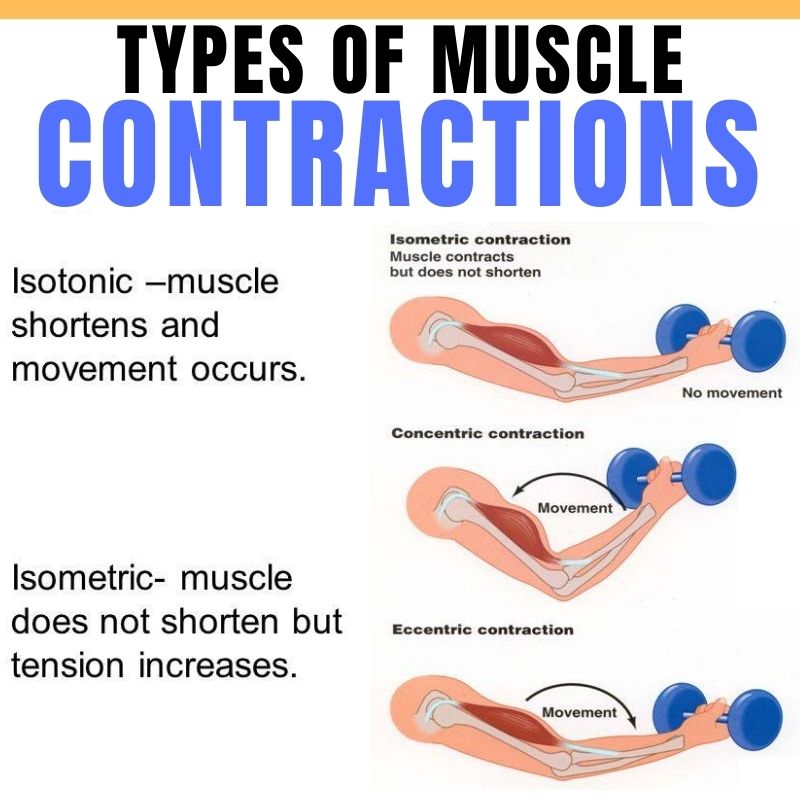 At first, you may have contractions once every 10 minutes, then once every 5 minutes, and so on. Braxton Hicks contractions don't have any set pattern. They come and go at random.
At first, you may have contractions once every 10 minutes, then once every 5 minutes, and so on. Braxton Hicks contractions don't have any set pattern. They come and go at random.
False contractions don't get more intense. Real ones gradually increase in strength.
Usually you'll feel Braxton Hicks contractions in one area of your belly. When you get up and walk, change position, or lay down and rest, they'll go away. True labor pains can spread throughout your belly, as well as to your lower back. And they won't stop, no matter what you do.
Other signs that you're in real labor include:
- Pressure in your lower belly
- Brown or reddish discharge from your vagina, called bloody show
- A trickle or rush of water from your vagina
If you're not sure which type of contractions you're having, time them and note whether they get closer together. Change position, rest, and see if they stop. Or drink a glass of water. Dehydration can trigger Braxton Hicks contractions.
When to Call Your Doctor
Talk to your doctor before you have contractions so you know what to expect. Ask about the signs of labor and the difference between real contractions and Braxton Hicks.
Call your doctor if you think you're in labor. Even if you're wrong, it's better to be on the safe side.
One way to tell whether you're in labor is to look for the 5-1-1 pattern. True labor contractions will come once every 5 minutes, last for at least 1 minute, and keep going for at least 1 hour.
Call your doctor right away or go into the office if you have any of these signs:
- Bleeding from your vagina
- Leaking of fluid -- a sign that your water has broken
- A change in your baby's movements, fewer than 10 movements in 2 hours
- Regular contractions before your 37th week of your pregnancy
How to determine pregnancy without a test
How to determine pregnancy without a test and what signs indirectly indicate that your beloved baby will be born soon? Of course, only a blood test can give a 100% guarantee, but the presence of certain signs may indicate its possible onset.
Classic signs of pregnancy
The most common early signs and symptoms may include
- Delayed menses. Problems with the regularity of the menstrual cycle may be associated with hormonal imbalance in the body. But if the delay arose for the first time, and before that the cycle was as accurate as a clock, then it is likely that you are pregnant.
- Early toxicosis with severe nausea and vomiting - the most common sign of an interesting situation, but not every woman has.
- Pain in both breasts or enlargement. Nipples can become very sensitive and change color. Sometimes in the early stages, colostrum is released from them with slight pressure.
- Pain in the pelvic region, similar to menstruation. But this sign can also indicate such a serious pathology as an ectopic pregnancy.
- Increased amount of discharge from the genitals. This can usually be observed during ovulation.
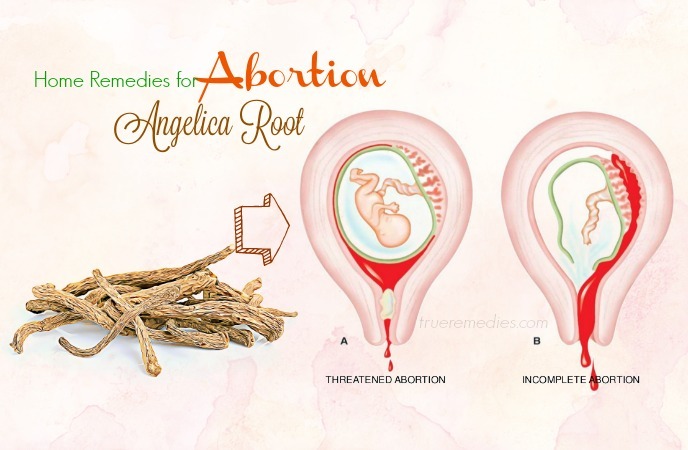 Normal discharge is clear and odorless. When a whitish tint or a curdled structure appears, thrush can also be assumed, which is a common problem for expectant mothers. But in this case, you can not do without treatment. During the period of bearing a child, it is necessary to protect your body as much as possible from any, even such a safe disease.
Normal discharge is clear and odorless. When a whitish tint or a curdled structure appears, thrush can also be assumed, which is a common problem for expectant mothers. But in this case, you can not do without treatment. During the period of bearing a child, it is necessary to protect your body as much as possible from any, even such a safe disease. - Increased or vice versa reduced libido. Every woman experiences jumps in sexual desire in one direction or the other due to hormonal changes occurring in the body. Therefore, men should treat this with understanding, knowing that they have not become less loved, but these are just signs of pregnancy.
- Frequent urination, despite the fact that you do not drink more often and there are no inflammatory diseases of the genitourinary system. A similar phenomenon is associated with a slight relaxation of the sphincter of the bladder due to hormonal processes. And with the growth of the uterus and, accordingly, with the increase in pressure on the bladder, going to the toilet will become even more frequent.

Additional symptoms of pregnancy
There are less obvious signs that may occur during the first trimester. These include:
- Strange Desires . For example, at night I sharply wanted chocolate, and during the day - salted fish. Such desires may not be mere whims. If you want sour, then perhaps there is not enough vitamin C in the body. You want to gnaw on the wall with calcium deficiency, and sniff gasoline - with a lack of iron, anemia.
- Constant irritability, tearfulness. The flow of hormones in a woman's body in the early stages can make her unusually emotional. So-called mood swings can be a clear sign of pregnancy.
- Bloating . Hormonal changes can cause feelings of fullness in the abdomen, as at the beginning of the menstrual cycle.
- Bloody discharge pale pink. This symptom is called implantation bleeding. This happens when a fertilized egg attaches to the lining of the uterus, about 10 to 14 days after conception.
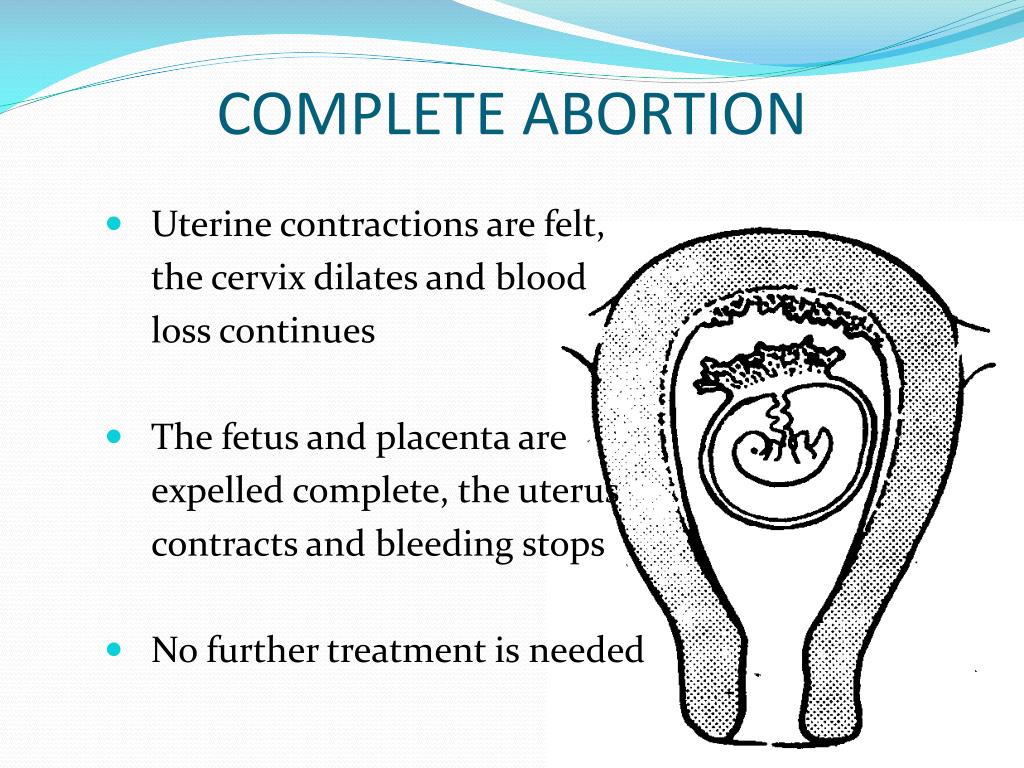 Usually occurs during the normal periods of the menstrual period. But not all women have such bleeding is a sign of a normal pregnancy. Therefore, in case of detection of deviations from the normal cycle, consult a gynecologist.
Usually occurs during the normal periods of the menstrual period. But not all women have such bleeding is a sign of a normal pregnancy. Therefore, in case of detection of deviations from the normal cycle, consult a gynecologist. - Chair problems . Hormonal changes cause the digestive system to slow down, which can lead to constipation.
- Food aversions . When you are pregnant, you may become more sensitive to certain smells and your sense of taste may change. Like most other symptoms, these eating habits can be attributed to hormonal changes.
- Nasal congestion . An increase in hormone levels and blood production can lead to swelling of the nasal mucosa. This can cause congestion or runny nose, nosebleeds.
90,000 first signs of pregnancy in the early stages
Basket
0 ₽
Basin
0 ₽
Publication date: 05/17/2021
For pregnant and nursing for stress -sisterArticle 9000
Svetlana Bukharova,
Nutritionist, fitness instructor
12 years of experience.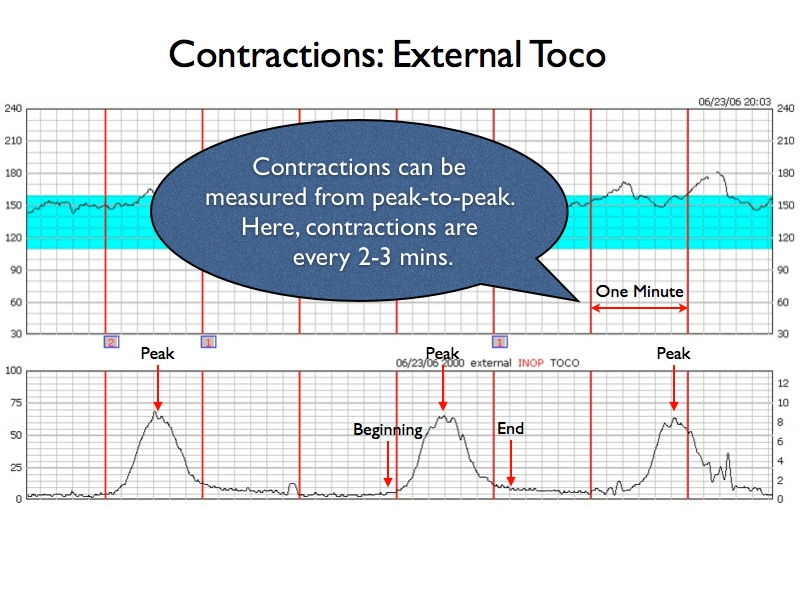 Diploma of Medical Education: DVS 1724848
Diploma of Medical Education: DVS 1724848
Article content
- How to understand the first signs of pregnancy without a test
- Signs of pregnancy in the early stages will help to determine the measurement of basal temperature
- Pregnancy symptoms - "Grandma's" methods of determining
- Determination of pregnancy by changes in well-being and mood
- Ask an expert on the topic of the article
Since ancient times, women have been looking for ways to find out about pregnancy as early as possible. Documents found during the study of the Egyptian pyramids (1370 BC) describe this method of early detection of pregnancy: a woman should urinate on barley and wheat seeds. If the grain sprouted shortly thereafter, the woman was considered pregnant.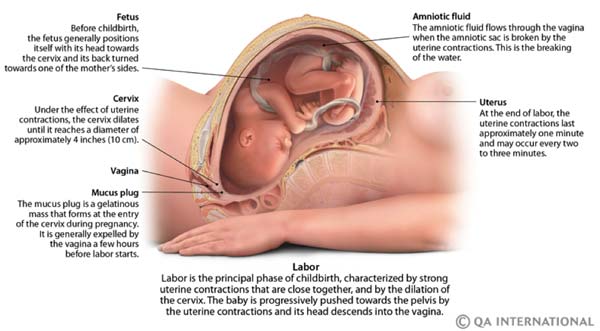 The method was tested by modern scientists in 1963, and it turned out that such a text is really effective in 70% of cases. This is due to an increase in the level of estrogen in the body of the expectant mother, which is excreted along with urine and accelerates the process of grain germination.
The method was tested by modern scientists in 1963, and it turned out that such a text is really effective in 70% of cases. This is due to an increase in the level of estrogen in the body of the expectant mother, which is excreted along with urine and accelerates the process of grain germination.
And at the end of the 17th century, the so-called "olfactory" method was popular. They set fire to a cloth soaked in women's urine. If the woman did not like the smell formed during burning, it was concluded that the lady was in position. However, there are many such methods, many of them have been tested for centuries and have the right to exist. In the article we will talk about the most effective testless methods for determining the "interesting position" - both medical and folk. The latter do not guarantee 100% reliability, since they do not have scientific justification and confirmation, but they will help not to delay a visit to the gynecologist.
How to understand the first signs of pregnancy without a test
Medical methods are the most reliable in determining pregnancy without a test. If you suspect that you are in an interesting position, go to the antenatal clinic. The gynecologist will examine you and direct you to donate blood for the hCG hormone.
If you suspect that you are in an interesting position, go to the antenatal clinic. The gynecologist will examine you and direct you to donate blood for the hCG hormone.
HCG
Blood should be taken in the morning on an empty stomach. The concentration of chronic genadotropin increased throughout pregnancy. If the egg is not fertilized, the indicator is 0-5 mU / ml. If the gestational age is from one to two weeks - 25-156 mU / ml.
Ultrasound
From the seventh day, the fact of conception can be determined by ultrasound. Ultrasound is needed not only to confirm pregnancy. The doctor will also determine the condition of the reproductive organs, the location of the embryo, and exclude an ectopic pregnancy.
Don't have time to read long articles? Follow us on social networks: listen to the video in the background and read short notes about beauty and health.
Megapharmacy in social networks: VKontakte, Telegram, OK, Viber
Signs of pregnancy in the early stages will help determine the measurement of basal body temperature
Gynecologists call this method one of the most reliable. At the beginning of the menstrual cycle, the basal temperature (BT) is kept at around 36.5 - 36.7 ° C, rises to 37 ° C by ovulation. In the event that there was no conception, after the cessation of ovulation, BT again decreases to average values. If you are pregnant, the temperature will be kept within 37 ° C.
At the beginning of the menstrual cycle, the basal temperature (BT) is kept at around 36.5 - 36.7 ° C, rises to 37 ° C by ovulation. In the event that there was no conception, after the cessation of ovulation, BT again decreases to average values. If you are pregnant, the temperature will be kept within 37 ° C.
How to measure basal body temperature?
A conventional thermometer is inserted into the rectum or vagina. The procedure should be carried out every day at the same time in the morning, without getting out of bed. When measuring temperature:
- Stay in the same position in which you woke up
- Measure BBT 5-8 minutes
- Write down the values (with date and time)
Important! During the period of determining the basal temperature, it is advisable not to smoke or drink alcohol.
Pregnancy symptoms - "Grandma's" methods of determination
You can determine pregnancy without a test using folk methods.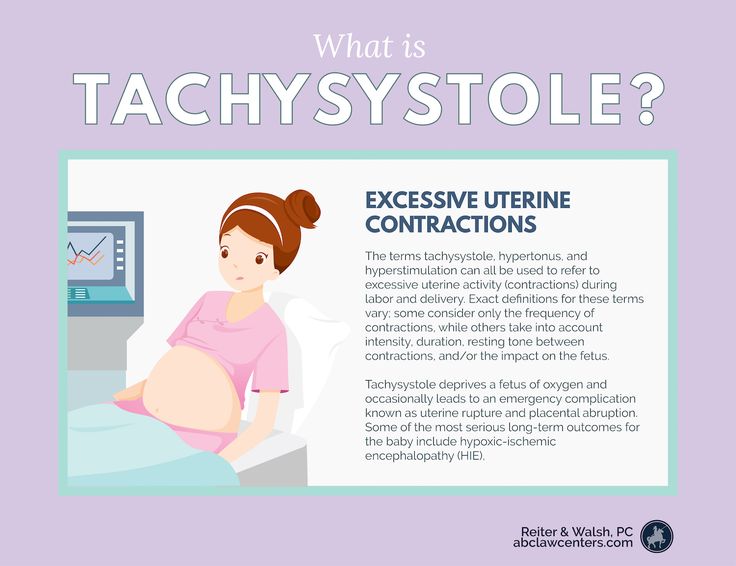 They are affordable, harmless to health and help you get quick results without leaving your home.
They are affordable, harmless to health and help you get quick results without leaving your home.
How does iodine help determine pregnancy?
You can find out that you are pregnant with regular iodine.
What you need:
- Napkin or sheet of paper
- Plastic or glass containers
- Iodine
- Pipette
What to do:
- Collect some urine in a container
- Soak tissue/paper in urine
- Lay out on a flat surface
- Pipette iodine
- Place a few drops on paper
Result:
- If the color of the iodine has not changed or changed to a bright dark blue, there is no pregnancy.
- If iodine has changed color to lilac or lilac, you are pregnant.
Advantages of the method:
- Everything you need is at hand
- Early pregnancy detection
Cons of the method:
- No 100% guarantee
- Accurate adherence to instructions
- Time limit: you only have 25 minutes for the test, then the urine becomes unusable
Find out about pregnancy with soda
What you need:
- Soda
- Urine
- container
What to do:
- Collect about 150-200 ml of morning urine in a container
- Pour 1 teaspoon baking soda into the urine
Results:
- The mixture bubbles and hisses, which means that the acidity is normal.
 you are not pregnant
you are not pregnant - Soda settled at the bottom, which means that my acidity is lowered. There is a high probability that conception has occurred.
Advantages of the method:
- Cheap
- Accessibility
Cons of the method:
- Efficiency not confirmed by studies
- May give a false result (due to the nature of the urine)
There is another method to test for a possible pregnancy, which does not require "chemical experiments". It consists of palpation of the pulse on the abdomen. Place your fingers on your abdomen two fingers below your navel. During pregnancy, the blood supply to this area increases, the pulse becomes more frequent and well audible.
Feeling and Mood Changes in Pregnancy Detection
There are several symptoms in early pregnancy before your period that might suggest you are pregnant before you see your doctor or buy a test. Listen to your body. You are probably pregnant if:
Listen to your body. You are probably pregnant if:
- No menstruation
- Feeling dizzy, there is a veil in front of the eyes
- Body temperature rises to 37 - 37.5°C for a long time
- Stuffy nose
- Enlarged, swollen breasts, the color of the nipples changed, they became hypersensitive
- Feeling of heaviness and pain in the navel, in the lower abdomen
- You feel sick, your sense of smell and touch are acute
- Overweight
- Frequent mood swings, tearfulness
- Weakness, increased drowsiness
- Gastronomic "shifts" - the desire to "taste" unsuitable for food substances, such as chalk. Cravings for salty, sweet, sour
- A sharp decrease or increase in sexual desire
There are many ways to determine pregnancy without a test, but you should not rely only on physiological changes occurring in your body and “grandmother's” tests. Finding out that you may soon become a mother is best from a gynecologist. Only a specialist will be able to prevent abnormalities in the development of the fetus and determine an ectopic pregnancy, if any. Modern diagnostic methods are very effective, and using them you can endure and give birth to a healthy baby.
Only a specialist will be able to prevent abnormalities in the development of the fetus and determine an ectopic pregnancy, if any. Modern diagnostic methods are very effective, and using them you can endure and give birth to a healthy baby.
Sources:
- Cyberleninka.ru L.A. Terebneva: The history of pregnancy tests and modern methods for determining short-term pregnancy. GBOU DPO Russian Medical Academy of Postgraduate Education of the Ministry of Health of Russia
- Elibrary.ru Pregnancy. Week after week. Desktop. book-calendar for expectant mothers and their caring loved ones. Glade Curtis; [Trans. from English: N.A. Shishkov]. - Ser. We are expecting a baby
- Сyberleninka.ru V.E. Kupchenko: Psychology of pregnancy: main directions of research. Omsk State University F.M. Dostoyevsky
- Elibrary.ru Peretyako L.P., Nazarov S.B., Fateeva N.V., Kuznetsov R.A.: Method for morphological determination of gestational age. FSBI "Ivanovo Research Institute of Motherhood and Childhood named after V.











